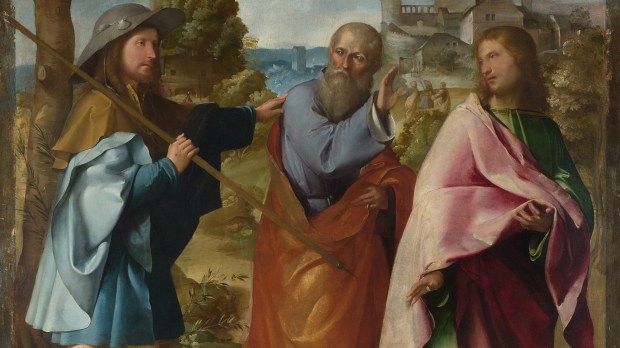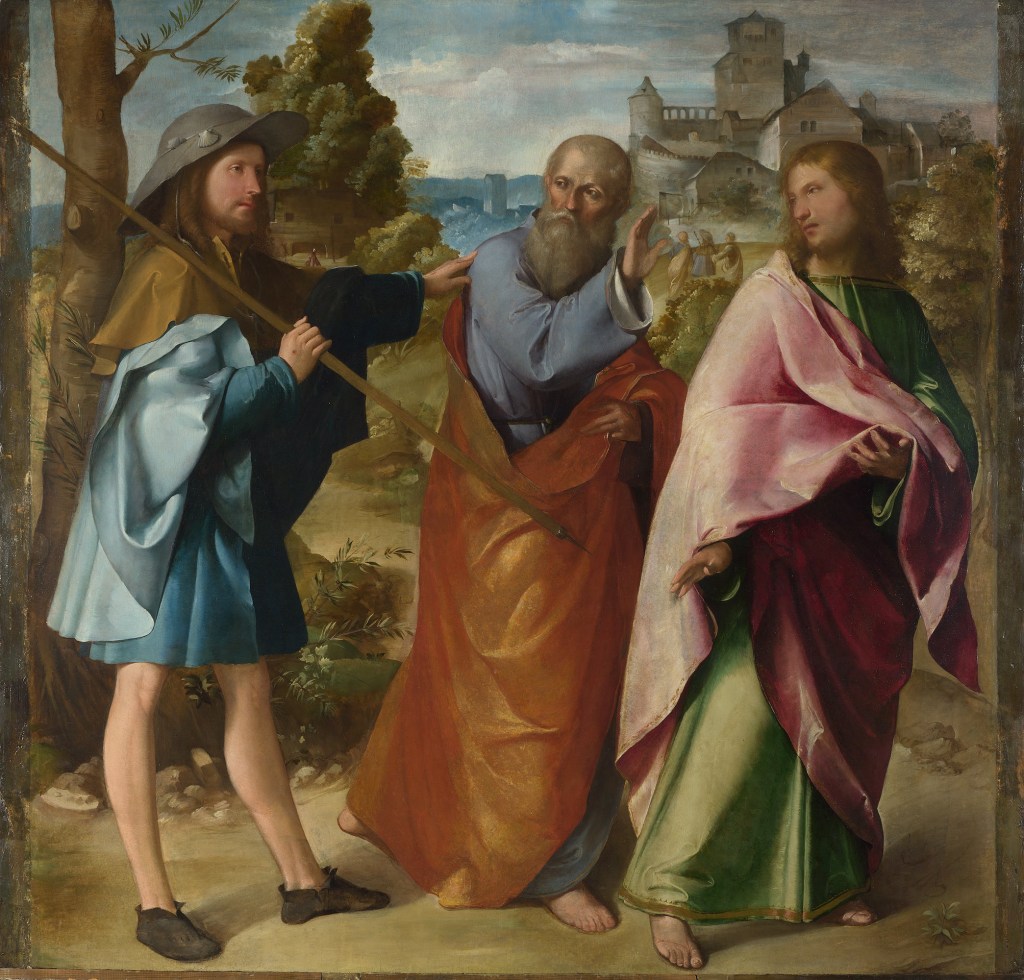This Sunday at Mass we will hear proclaimed the Gospel of the disciples on the road to Emmaus as they encounter the Risen Jesus (Lk 24:13-35). One guide to understanding this mystery is the Italian Renaissance painter Altobello Melone (+1543).
A wake-up call
The Gospel describes the two disciples on the road to Emmaus as “looking downcast” — a dangerous way to look. This word elsewhere in the Gospels is used to refer to the gloomy demeanor of the hypocrites (see Mt 6:16). St. Augustine says that these two were so shattered when they saw Jesus hanging on the cross that they totally forgot about his teaching. Nonetheless, St. Thomas Aquinas reminds us that “of all the passions, sadness causes the most injury to the soul.”
It seems inconceivable that the first disciples of Jesus could so quickly lose heart and cave in on themselves. But the Emmaus episode serves as a wake-up call that a similar pessimistic, defeatist attitude can derail even the most committed of believers if we are not attentive.
Catholic spirituality has coined a name for it. The Emmaus disciples are suffering from the spiritual malaise of inconstancy. Fr. Adolphe Tanquerey, S.S. (+1932), in his classic text The Spiritual Life, singles out inconstancy as one of the four temptations that often afflict beginners once they set out on the life of faith:
A moment arrives when God’s grace is given in a less sensible manner than before, when the soul grows weary of essaying again the self-same efforts, which seem to be thwarted by the self-same difficulties.
Melone captures the disciples’ dejection and discouragement. The two disciples deliberately have their backs turned on Jesus, even after he has called out to them. Their posture is one of defiance, wanting nothing of what the traveler has to offer. As Jesus catches up to them, the gray-bearded disciple puts his hand up in a gesture of declining, of spurning, as if to say, “We’re not interested in what you have to say to us.” The other thrusts out his hand in dismissal, shooing off Jesus, gesticulating, “Go away. Leave us alone.” The body language of both screams “Scram!”
One of the graces of the Resurrection is accepting in faith that God permits lukewarmness and pusillanimity as ingredient to the process of our self-perfection. St. Ignatius of Loyola brilliantly observes, “Desolation is visited on us so that we are not able to build our nest where we do not belong.”
What can we do when laxness tempts us to give up? Fr. Tanquerey proposes a remedy:
We must realize that the work of perfection is a work of long endurance, demanding much steadiness of purpose, and that only those succeed who, despite partial setbacks, return again and again with fresh energies to the task.
Jesus always comes to us
Another grace of the Resurrection revealed through Emmaus is this: Jesus always comes to us … especially when we deserve him not at all and we are the least disposed to receive him. The fact is that nothing but his Presence can rescue us from our predicament. As Fr. Julián Carrón points out: “Jesus’ message and even all the miracles he performed were not enough to overcome the sadness of his disciples on the road to Emmaus — only his risen Presence could ignite their hearts once again.”
Yet, keep in mind: How does Jesus come to us? He frequently appears by way of surprise, in forms we don’t expect, in a fashion we would never imagine. That’s what Melone portrays in his painting … literally.
Start by looking just at the left side of the painting. Who is this character dressed in blue? Based on his fashion of dress, we conclude he’s a guy from the Renaissance.
Now check out his accessories. What’s with that floppy hat, and the shell, and the staff, not to mention the cool moccasins? Here is what Melone wants us to realize: this wayfarer is a pilgrim … just like you! The artist conceives of the road to Emmaus as a kind of Camino de Santiago — the Way of St. James. Ever since the 9th century, Christians have been setting out on pilgrimage from any number of different starting points within Europe and spending weeks, months, and even years walking to the shrine of the Apostle St. James the Greater in the Cathedral of Santiago of Compostela in northwestern Spain. The Camino became one of the major and most renowned of Catholic pilgrimages in the later Middle Ages.
The pilgrim’s wide-brimmed hat provides protection from the sun. The staff he carries serves as a walking stick, and the hook on top can hold a small bundle of belongings. The pilgrim is tricked out for trekking shod in sturdy footwear. But notice especially the scallop shell on the pilgrim’s hat — to this day, the scallop shell is the badge of the Compostela pilgrim, associated as it is with the transferal by sea of the relics of St. James from the Holy Land to Spain not long after his death.
The painting’s point is this: It is one thing not to recognize who Jesus is, but it is even more tragic not to recognize who we are. No matter how discouraged we may get, we are always pilgrims in search of God and sainthood. The Emmaus event is not a happenstance meeting with some stranger on the road. Rather, it is an encounter with God himself, ordained by divine providence to call us back to ourselves. And even though the disciples “were restrained from recognizing Jesus” (Lk 24:16), if we live with Gospel vigilance, paying attention to the desires of our heart no matter how sad we may be at the moment, we will realize that our hearts are made for this man who comes to meet us … because our hearts our made by him. “Were not our hearts burning inside us as he talked to us on the road” (Lk 24:32).
Melone does include one amazing clue to cue us in to the true identity of this traveler. If you look closely at his right hand, you will spot the red, bruised mark of a nail. The One who accompanies us is wounded like us.
Now switch to the right side of the painting. The attire of the two men makes clear that they have stepped right out of the pages of the New Testament. But why this anachronism — combining a Renaissance figure with two biblical types? It is to convince us that Christ’s coming is always current and contemporary. Jesus comes to us in our day — just as did to the Emmaus disciples — according to our predisposition, our manner, and the aspects of our culture in order to convince us how relevant the Gospel perpetually is.
Not only that, the Risen Jesus is forever reaching out his hand to us, eager to touch us in our struggle and misery, just as he lovingly touches the shoulder of the big-bearded disciple.
And once the two disciples finally let down their guard and are willing to engage this man so eager to be part of their suffering, Jesus asks: What are you discussing as you go your way? What are the things that have gone on in the past few days? (Lk 24:17, 19). A brilliant 17th-century biblical commentator observed:
Christ constrains them to describe their heartache in detail and to lay bare their sorrow about Jesus crucified along with their doubts as to his Resurrection.
Because that is what begins to convert downcast hearts into burning hearts.
And, wondrously, what starts as rejection is transformed into friendship. Jesus “interpreted for them every passage of Scripture which referred to him” (Lk 24:27). Fr. Walter Hilton (+1396) says that “the lover of God is God’s friend, not because a person deserves to be, but because God in his merciful goodness has made them so by a very real pact. And so it is that God shows them his secrets as to a true friend.”
The fact of the pact that has made them true friends is revealed in the disciples’ pleading: “Stay with us” (Lk 24:29). If you look very closely at the painting, you will see this depicted in miniature. There in the background are three tiny figures making their way to the nearby village for dinner. The younger disciple places his left hand on Jesus’ back in an affectionate gesture of friendship. Jesus has cocked his hat at a rakish slant as if he’s off to a party.
The effect of the encounter
And we know what happens next, when Jesus breaks bread with them. Pope St. Leo the Great notes:
As the two disciples shared their meal with Jesus, their eyes were opened in the breaking of bread, opened far more happily to the sight of their own glorified humanity than were the eyes of our first parents to the shame of their sin.
What is their response? They get up immediately with the desire to rush back to Jerusalem. They cannot wait to share their encounter with the Eleven and with the world. They exit the nest where they do not belong. More than anything, what moves people to believe their witness? A Presence that has come to meet them.
~
Find Fr. Peter John Cameron’s reflection on the Sunday Gospel each week here.



